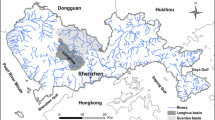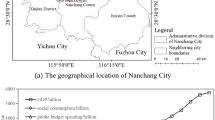Abstract
Shanghai is one of the largest metropolitan areas in the world, during the rapid urbanization of the past decades, impervious surface expanded dramatically and became a main factor influencing surface water quality. Thus, exploring the driving forces of impervious surface has great implications in such metropolitan area. In this study, an impervious surface coefficient method (ISC) was used to measure the percentage of total impervious area (PTIA) of Shanghai; regression analysis was conducted to define the relationship between PTIA and three socio-economic factors, population density, unit area gross domestic product, and unit area industrial output at the city and district scale. Results showed that the industrial land use generated the highest ISC value, followed by high-density residential. Strong correlations were showed between PTIA and socio-economic indicators, in which population density was the most significant. Threshold effect was presented that when population density was higher than 15000 per/km2, this relationship would become less significant and PTIA remained stable. Similar effects were found when unit area gross domestic product exceeded 125 million yuan/km2. Scale effect was also discussed that the relationship was more significant at city scale than district. An improved understanding of the threshold effect and scale effect will help guide future urban planning and design new urban ecosystem policies.






Similar content being viewed by others

References
Azar, D., Graesser, J., Engstrom, R., Comenetz, J., Leddy, R. M., Schechtman, N. G., & Andrews, T. (2010). Spatial refinement of census population distribution using remotely sensed estimates of impervious surfaces in Haiti. International Journal of Remote Sensing, 31(21), 5635–5655. https://doi.org/10.1080/01431161.2010.496799.
Barbara, W., Katie, Y., et al. (2010). User’s guide for the California impervious surface coefficients. California Environment Protection Agency: United States.
Beck, S. M., Mchale, M. R., & Hess, G. R. (2016). Beyond impervious: urban land-cover pattern variation and implications for watershed management. Environmental Management, 58(1), 15–30. https://doi.org/10.1007/s00267-016-0700-8.
Cao, S., Hu, D., Zhao, W., Mo, Y., & Zhang, Y. (2019). Monitoring changes in the impervious surfaces of urban functional zones using multisource remote sensing data: a case study of Tianjin, china. GIScience & Remote Sensing. https://doi.org/10.1080/15481603.2019.1600110.
Carlson, T. N. (2001). Impervious surface area and residential housing density: a satellite perspective. Geocarto International, 16(1), 15–20. https://doi.org/10.1080/10106040108542178.
Chabaeva, A., Civco, D. L., & Hurd, J. D. (2009). Assessment of impervious surface estimation techniques. Journal of Hydrologic Engineering, 14(4), 377–387. https://doi.org/10.1061/(ASCE)1084-0699(2009)14:4(377.
Chaudhuri, A. S., Singh, P., & Rai, S. C. (2017). Assessment of impervious surface growth in urban environment through remote sensing estimates. Environmental Earth Sciences, 76(15), 541.
Chen, S., Zhang, X. Y., & Peng, L. H. (2006). Impervious surface coverage in urban land use based on high resolution satellite images. Resources Science, 28(2), 41–46.
Chen, L., Ren, C. Y., Zhang, B., Wang, Z. M., & Liu, M. Y. (2018). Quantifying urban land sprawl and its driving forces in Northeast China from 1990 to 2015. Sustainability, 10(1), 188. https://doi.org/10.3390/su10010188.
Choi, K. S., & Ball, J. E. (2002). Parameter estimation for urban runoff modelling. Urban Water,4(1), 31-41. https://doi.org/10.1016/S1462-0758(01)00072-3.
Dhorde, A. A., Dhorde, A., & Joshi, G. (2012). Population calibrated land cover impervious surface coefficients for Upper Bhima basin. International Journal of Geomatics & Geosciences, 4, 7–1047.
Eng, I. (2010). The rise of manufacturing towns: externally driven industrialization and urban development in the pearl river delta of china. International Journal of Urban & Regional Research, 21(4), 554–568. https://doi.org/10.1111/1468-2427.00101.
French, S. P. (2009). Regional impervious surface estimation: an urban heat island application. Journal of Environmental Planning and Management, 52(4), 477–496. https://doi.org/10.1080/09640560902868207.
Guo, H., & Huang, Q. (2013). Spatiotemporal analysis of urban environment based on the vegetation–impervious surface–soil model. Journal of Applied Remote Sensing, 8(1), 084597. https://doi.org/10.1117/1.JRS.8.084597.
Hafsi, R., Ouerdachi, L., Kriker, A. E., & Boutaghane, H. (2016). Assessment of urbanization/impervious effects on water quality in the urban river Annaba (Eastern Algeria) using physicochemical parameters. Water Science & Technology, 74(9), 2051–2059. https://doi.org/10.2166/wst.2016.350.
Henits, L., Mucsi, L., & Liska, C. M. (2017). Monitoring the changes in impervious surface ratio and urban heat island intensity between 1987 and 2011 in Szeged, Hungary. Environmental Monitoring & Assessment, 189(2), 86–13. https://doi.org/10.1007/s10661-017-5779-8.
Jacobson, C. R. (2011). Identification and quantification of the hydrological impacts of imperviousness in urban catchments: a review. Journal of Environmental Management, 92(6), 1438–1448. https://doi.org/10.1016/j.jenvman.2011.01.018.
Jat, M. K., Garg, P. K., & Khare, D. (2008). Monitoring and modelling of urban sprawl using remote sensing and GIS techniques. International Journal of Applied Earth Observation and Geoinformation, 10(1), 26–43. https://doi.org/10.1016/j.jag.2007.04.002.
Li, M., Zang, S., Wu, C., & Na, X. (2018). Spatial and temporal variation of the urban impervious surface and its driving forces in the central city of Harbin. Journal of Geographical Sciences, 28(3), 323–336. https://doi.org/10.1007/s11442-018-1475-z.
Liao, C., Dai, T., Cai, H., & Zhang, W. (2017). Examining the driving factors causing rapid urban expansion in china: an analysis based on globeland30 data. ISPRS International Journal of Geo-Information, 6(9), 264. https://doi.org/10.3390/ijgi6090264.
Lu, D. S., & Weng, Q. H. (2006). Use of impervious surface in urban land-use classification. Remote Sensing of Environmen, 102(1-2), 146–160. https://doi.org/10.1016/j.rse.2006.02.010.
Ma, L. J. C. (2002). Urban transformation in china, 1949-2000: a review and research agenda. Environment & Planning A, 34(9), 1545–1569. https://doi.org/10.1068/a34192.
Ma, Q., He, C. Y., & Wu, J. G. (2016). Behind the rapid expansion of urban impervious surfaces in China: Major influencing factors revealed by a hierarchical multiscale analysis. Land Use Policy, 59, 434–445. https://doi.org/10.1016/j.landusepol.2016.09.012.
Ma, Q., Wu, J., He, C., & Hu, G. (2018). Spatial scaling of urban impervious surfaces across evolving landscapes: from cities to urban regions. Landscape & Urban Planning, 175, 50–61. https://doi.org/10.1016/j.landurbplan.2018.03.010.
Nagy, R. C., Lockaby, B. G., Kalin, L., & Anderson, C. (2012). Effects of urbanization on stream hydrology and water quality: the Florida Gulf Coast. Hydrological Processes, 26(13), 2019–2030. https://doi.org/10.1002/hyp.8336.
Prisloe, S., Lei, Y., & Hurd, J. (2001). Interactive GIS-based impervious surface model. Proceedings of the 2001 ASPRS Annual Convention, St. Louis, MO. CD-ROM. American Society for Photogrammetry & Remote Sensing.
Rashed, T., Weeks, J. R., Gadalla, M. S., & Hill, A. G. (2001). Revealing the anatomy of cities through spectral mixture analysis of multispectral satellite imagery: a case study of the greater Cairo region, Egypt. Geocarto International, 16(4), 7–18. https://doi.org/10.1080/10106040108542210.
Sekertekin, A., Abdikan, S., Marangoz, A. M. (2018) The acquisition of impervious surface area from LANDSAT 8 satellite sensor data using urban indices: a comparative analysis. Environmental Monitoring and Assessment, 190, (7).
Shanghai Statistical Bureau. (2007). Shanghai Statistical Yearbook. Beijing: China Statistics Press
Sleavin, W. J., Civco, D. L., Prisloe, S., Educator, A., Giannotti, L., & Coordinator, N. P. (2000). Measuring impervious surfaces for non-point source pollution modeling. Proceedings Asprs Annual Convention.
Tahmina, A., Philippe, Q., Steven, J. E., & Guido, V. (2018). Impacts of climate and land use changes on flood risk management for the Schijn River, Belgium. Environmental Science & Policy, 89, 163–175. https://doi.org/10.1016/j.envsci.2018.07.002.
Uygun, B. S., & Albek, M. (2015). Determination effects of impervious areas on urban watershed. Environmental Science and Pollution Research, 22(3), 2272–2286. https://doi.org/10.1007/s11356-014-3345-2.
Weng, Q. (2012). Remote sensing of impervious surfaces in the urban areas: requirements, methods, and trends. Remote Sensing of Environment, 117(2), 34–49. https://doi.org/10.1016/j.rse.2011.02.030.
Wu, C. S., & Murray, A. T. (2003). Estimating impervious surface distribution by spectral mixture analysis. Remote Sensing of Environment, 84(4), 493–505. https://doi.org/10.1016/S0034-4257(02)00136-0.
Xian, G. (2008). Satellite remotely-sensed land surface parameters and their climatic effects for three metropolitan regions. Advances in Space Research, 41(11), 1861–1869. https://doi.org/10.1016/j.asr.2007.11.004.
Xian, G., & Crane, M. (2005). Assessments of urban growth in the Tampa Bay watershed using remote sensing data. Remote Sensing of Environment, 97(2), 203–215. https://doi.org/10.1016/j.rse.2005.04.017.
Xian, G., Crane, M., & Su, J. (2007). An analysis of urban development and its environmental impact on the Tampa Bay watershed. Journal of Environmental Management, 85(4), 965–976. https://doi.org/10.1016/j.jenvman.2006.11.012.
Yan, Z. G., Teng, M. J., He, W., Liu, A. Q., Li, Y. R., Wang, P. C. (2019). Impervious surface area is a key predictor for urban plant diversity in a city undergone rapid urbanization. Science of The Total Environment, 650, 335–342. https://doi.org/10.1016/j.scitotenv.2018.09.025.
Yue, W. Z. (2009). Improvement of urban impervious surface estimation in Shanghai using Landsat7 ETM+ data. Chinese Geographical Science, 19(3), 283–290. https://doi.org/10.1007/s11769-009-0283-x.
Zhao, J. (2008). Landscape pattern change and its environmental response across multiple spatial scales in tidal plain
Acknowledgments
We thank the Key Laboratory of Geographic Information Science, Ministry of Education of East China Normal University, for providing land use data of Shanghai.
Funding
The study was funded by the National Natural Science Foundation of China (41101550).
Author information
Authors and Affiliations
Corresponding author
Additional information
Publisher’s note
Springer Nature remains neutral with regard to jurisdictional claims in published maps and institutional affiliations.
Rights and permissions
About this article
Cite this article
Fu, B., Peng, Y., Zhao, J. et al. Driving forces of impervious surface in a world metropolitan area, Shanghai: threshold and scale effect. Environ Monit Assess 191, 771 (2019). https://doi.org/10.1007/s10661-019-7887-0
Received:
Accepted:
Published:
DOI: https://doi.org/10.1007/s10661-019-7887-0



